edit Steps
Delete Method
- 1If you have only just installed Windows Genuine Advantage notifications, simply using the system restore function will remove the program. Then refuse to accept the WGA update next time Windows updates. Otherwise, proceed as detailed below. (NOTE: If you try these steps while you are in "Safe Mode," step #8 is unnecessary).
Recommended Download
Fix Process Errors. Boost PC Speed Microsoft Certified. Free Download
Uniblue.com/FixProcessErrors - 2First, try the following:
- 3Open a Command Prompt window by clicking on Start -> Run. Type CMD and press OK.
- 4Change Directory into the System32 Folder (type cd \windows\system32)
- 5Open a Notepad window and type the following lines:
- taskkill -IM wgatray.exe
- del wgatray.exe
- del wgalogon.old
- 6Highlight and copy the three lines above to the Clipboard.
- 7Paste the contents of the Clipboard to Command Prompt.
- 8This should kill the wgatray.exe process from the Taskbar and immediately delete both files wgatray.exe and wgalogon.dll without the need to to go through all steps bellow.
- 9If that does not work, follow the steps below:
- 10Open System32 by either of the following methods:
- Click "Start" -> "Run", then type "system32". Click "Okay".
- Find system32 manually by clicking "Start" > "My Computer" > "(C:)" (or whatever your drive letter is) > "WINDOWS" > "system32".
- 11In "system32", go to "Tools" > "Folder options", click on the tab, "View", and uncheck "Hide extensions for known file types" if it is not already.
- 12Check to make sure the window that comes up has a full screen of various files. The files are in alphabetical order, which makes it easier to locate the specific file.
- 13Find "WgaLogon.dll" and rename it "WgaLogon.dll.bak".
- 14Create an empty copy of WgaLogon.dll:
- Right click on a blank space in system32 and select "New" > "Text Document".
- Leave the text document empty and label it "WgaLogon.dll". Press Enter (on your keyboard).
- You may get a warning from the above step that says, "If you change a file name extension, the file may become unusable. Are you sure you want to change it?". Click "Yes" on this warning.
- 15Be ready to complete the next two steps very quickly! Find "WgaTray.exe" in "system32" and delete it. You will then have 5 seconds to find "WgaTray.exe" in the Task Manager (the next step). NOTE: If you remove the files mentioned above while you are in "Safe Mode," step #8 is unnecessary.
- 16Immediately open Task Manager. You can do this by pressing the Ctrl, Shift, and Esc keys simultaneously, pressing the Ctrl, Alt, and Delete keys simultaneously, or right clicking the Taskbar and selecting "Task Manager". Click on the process tab and click end process when "WgaTray.exe" is selected. Note: If you take longer, do not panic! All that will happen is that "WgaTray.exe" will keep reappearing in the processes list (i.e. you won't be able to delete it as required). To remove the notifications after this, return to system32. You will find two files:"WgaLogon.dll.bak" (the one you renamed) and an Application Extension (0KB) called "WgaLogon.dll". Delete the Application Extension, rename "WgaLogon.dll.bak" to "WgaLogon.dll" and repeat the steps from the fifth one onwards (at a greater speed!!).
- 17Restart your computer once you have finished. All the notification messages should be gone.
Rename Method
- 1Open a CMD window by clicking on Start -> Run -> type CMD and click OK.
- 2Open a Notepad window (Start -> Run type NOTEPAD click OK) and type or copy (select the lines, and then press Ctrl-C) the following lines and paste (Ctrl-V) into the Notepad window:
- CD %systemroot%\system32
- rename wgatray.exe wgatray.exe.bak
- rename wgalogon.old wgalogon.old.bak
- rename LegitCheckControl.dll LegitCheckControl.dll.bak
- taskkill /F /T /IM wgatray.exe
- del wgatray.exe.bak
- del wgalogon.old.bak
- del LegitCheckControl.old.bak
- 3Make sure there is a blank line at the end of the text document, right after the last line.
- 4Select all the text (Ctrl-A) and copy to the clipboard (Ctrl-C)
- 5Paste the clipboard into the CMD Window (right click -> Paste)
- 6This should kill the wgatray.exe process and delete the files it uses.
if the there are not the above files(wgatray,...) in your system32 folder, then simply search for wga in the windows folder .you will find wga related files in a folder with the name "KB905474" that has been added during a windows update.delete the said folder and restart your PC.
Here is my steps: Same as above "CMD" and go to c:\windows\system32 steps A). tpye in command:
taskkill -IM wgatray.exe "Enter" to run the commandB). Under Windows to delete files: wgatray.exe, wgalogon.old because access denied
Mouse point go to "Start" --> right click --> Explore --> go to C:\windows\system32 Find the files: wgatray.exe wgalogon.old
Select those two files by left tick first one and hold shift key down left tick second file
Then right click mouse and a menu will pump up, select "CUT"
Go to desktop, and right click mouse, select "Paste". The files wgatray.exe wgalogon.old have been moved to desktop.
Select wgatray.exe wgalogon.old on desktop and delete files.
edit Tips
- This process will only get rid of the notifications, and will not validate your copy of XP. It will remove the timer at the beginning of your XP log on, the white notice on the log on screen, and the annoying yellow star that appears in the bottom right corner of the screen.
Event Log Management
Free event log information, tools, and strategies for compliance.
www.WhatsUpGold.com/EventLog - This is easier to do if you have someone reading the steps to you while you do it.
- You may need to Find Hidden Files and Folders in Windows to get to System32 manually.
- If task manager processes are moving, click the title of the "image name" row to freeze them.
- If you are having problems after this, disable the updates before rebooting.
- There is a program called RemoveWGA which does all of this for you. Just run the program, click yes, and you're done. (See External Links, below.)
- If you have problems changing files in the system32 directory, you will have to turn off System Restore. Go to "Start" -> "Control Panel" -> "System" -> "System Restore" and check the "Turn off system restore" check box.
- You will not be able to use Automatic Updates anymore; instead, you have to manually update them. In External Links, there is a program that will allow you to update any system, regardless of if it is genuine or not.
- You can also rename WgaTray.exe to WgaTray.exe.bak if you can't remove WgaTray.exe from your Taskbar. Press Ctrl+Shift+Escape to do so.
- It will be useful to have Task Manager open first before deleting WgaTray.exe
- Unlocker is a free program that can assist in removing WGA notifications.
edit Warnings
- Do not edit anything but what is told in system32, or it could cause system start up failure.
- If you are new to computers, do not attempt this because if you modify the wrong file you may crash your computer.
- This is not required for systems older than Windows 2000, as older versions of Windows do not have WGA installed. This list includes Windows 3.1, 95, 98, NT 3.51, and NT4. (WGA now installs for Windows 2000 searching for the most commonly used pirated keys.)
- If you don't have a genuine version of Windows, it's better to get it because you will be eligible get non-critical updates, IE7/8, and Media Player 11.
- If you are not using a genuine version you will still receive critical updates.








 Windows Genuine Advantage (WGA for short) is a
Windows Genuine Advantage (WGA for short) is a 







 Microsoft Office Outlook is the only program that Windows phones synchronize information with by default, so if you don't have Outlook installed, a warning message appears, and the e-mail, calendar, tasks, notes, and contacts on your Windows phone won't be synchronized with your desktop computer. Click OK to dismiss the message if it appears.
Microsoft Office Outlook is the only program that Windows phones synchronize information with by default, so if you don't have Outlook installed, a warning message appears, and the e-mail, calendar, tasks, notes, and contacts on your Windows phone won't be synchronized with your desktop computer. Click OK to dismiss the message if it appears.

 You'll see a progress indicator as Windows Mobile Device Center configures the phone and the computer. After a few moments, a new screen appears and the first synchronization starts.
You'll see a progress indicator as Windows Mobile Device Center configures the phone and the computer. After a few moments, a new screen appears and the first synchronization starts.




























